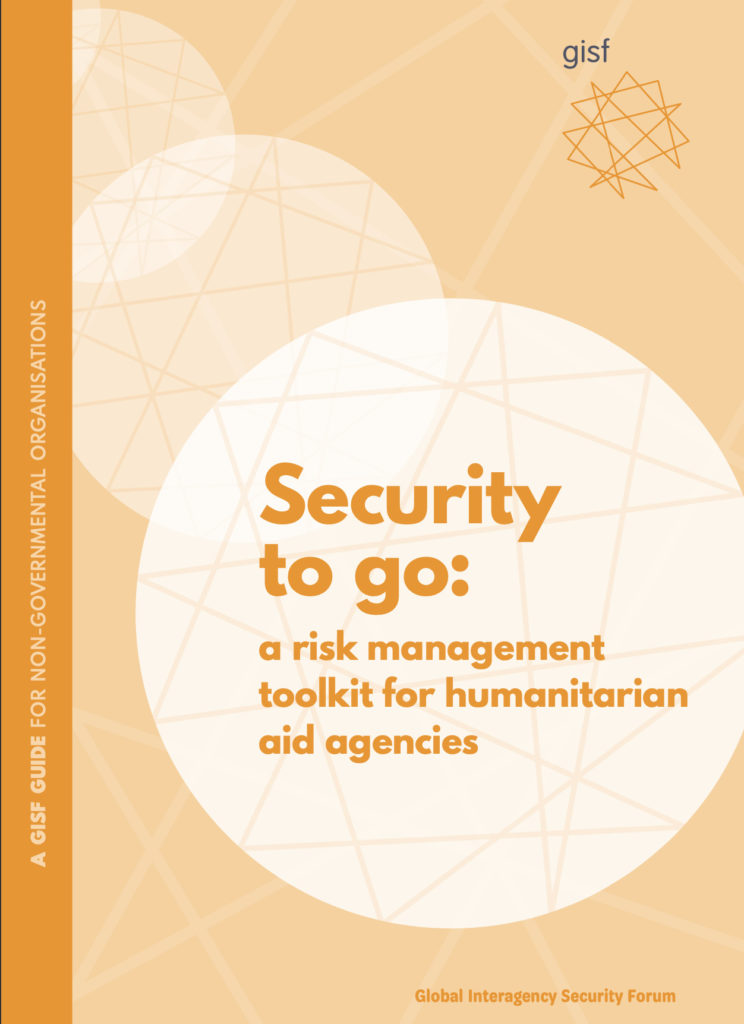Security to go: a risk management toolkit for humanitarian aid agencies (2020) is intended to provide a simple, easy-to-use guide for non-security experts to quickly set up basic safety, security and risk management systems in new contexts or rapid onset emergency response situations. This guide is applicable to both international organisations and national agencies moving into new regions and/or setting up new programmes. It is especially applicable to environments where the risk levels have changed due to human or natural causes.
This guide can be used in a number of ways. It can be saved to a memory stick as a whole, or readers can select only those modules they’re interested in. It can be also printed off and carried by staff deploying into a new context to act as a template for setting up systems and policies at an early stage, and keep staff safe as they set up a programme. Ideally, the document should be considered by management as part of the deployment planning process, programme design planning, or factored into an organisation’s scaling up in response to an emergency or significant change to the threat environment.
Security to go is not an exhaustive examination of all safety, security and risk management systems that can be developed or implemented by national and international organisations working in challenging contexts. Instead, ‘Security to go’ is intended to give guidance on the key needs that must be addressed in opening a new office, programme or mission. This guide uses checklists and step-by-step tools to ensure important duty of care needs are identified and managed.
The contents of this guide are the results of a collaboration between a number of different types of organisations, individuals and consulting agencies that focus on safety and security issues for international humanitarian organisations. The topics selected for inclusion in this guide represent many key areas but it is hoped additional modules will be added or updated in the future as organisations develop and share their lessons learned in various contexts.
Based on the content of this guide, we’ve worked with Disaster Ready to create a series of 5 short, interactive mobile guides, which make up the Security Risk Management Toolkit.
For ease of understanding, this guide is organised into three categories of modules: Planning and preparedness, Response, and Support services.
The planning, preparedness and response modules of this guide correspond to the security risk management planning process (see page vi). At the start of each chapter a navigational chart highlights in green which stage of the process will be discussed.
Modules under support services cover areas and processes that affect, complement and feed into an organisation’s security risk management and should be considered throughout the security risk management planning process.
The 4th version of Security to Go is available in English, whilst earlier versions of the guide are also available in Spanish and French.
Planning and Preparedness
Module 3: Risk Assessment Tool
Module 5: Security Strategies: acceptance, protection and deterrence
Module 6: NGO Security Coordination and other sources of support
Module 8: Security of Facilities
Module 9: Communications and Information Security
Module 10: Travel Safety: airports, vehicles and other means of transport
The first edition of this guide, published in 2015, was developed jointly by James Davis (Act Alliance) and Lisa Reilly, Executive Coordinator of the Global Interagency Security Forum (GISF). The project manager of the first edition was Raquel Vazquez Llorente, Researcher at GISF.
The second edition of this guide, published in 2017, saw the addition of ‘People Management’. This module was developed by Christine Williamson. The project manager was Adelicia Fairbanks, Research Advisor at GISF.
The latest edition of the guide sees the addition of ‘Digital Security’, developed by James Davis. The project manager was Léa Moutard, Research Advisor at GISF.
Suggested citation
Davis, J. et al. (2020) Security to go: a risk management toolkit for humanitarian aid agencies. 4th edition. Global Interagency Security Forum (GISF).
